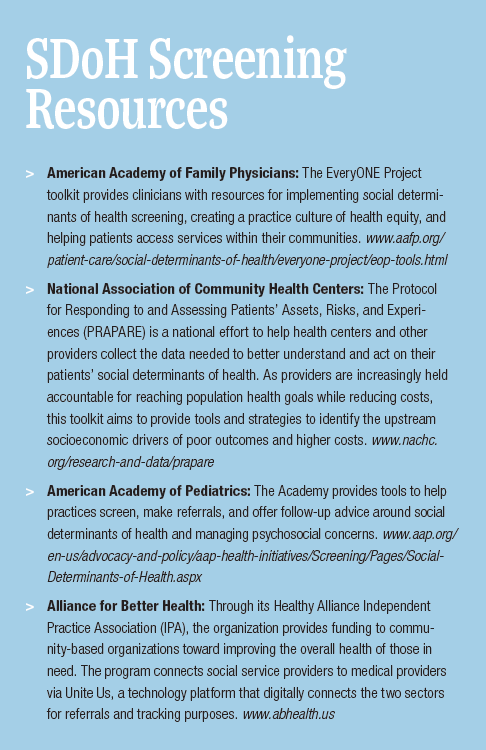A Prescription for Social Determinants of Health
New programs support physicians in addressing these key drivers of health outcomes
By Megan Headley
It’s become more widely accepted that social determinants of health (SDoH)—the environmental conditions in which people live, learn, work, play, worship, and age—affect a wide range of health outcomes. More and more government initiatives are being launched to call attention to the environment’s role in population health. However, one group remains surprisingly under-involved in linking these conditions to chronic or other illnesses: physicians.

A September 2019 study published in JAMA found that only 24% of hospitals and 16% of physician practices reported screening for five key social factors that affect health outcomes. Those factors, as defined by CMS’ Accountable Health Communities model, are food insecurity, housing instability, utility needs, transportation needs, and interpersonal violence.
Perhaps those low levels of screening aren’t so surprising, suggests Jacob Reider, MD, CEO of Alliance for Better Health and the former chief medical officer and Deputy Director of the Office of the National Coordinator of Health IT under President Obama. The former family doctor explains, “When I think of somebody in my office and I’ve just administered a questionnaire and identified social needs for somebody with a food security problem or maybe about to lose their house, I can tell you the feeling that I get is one of fear and dread. I just don’t know what to do. I don’t have the tools to write a prescription for this.”
Through the Alliance, Reider is seeking to create this prescription. Reider notes that vested organizations and physicians have long seen this problem as akin to identifying “how to eat an elephant.” Desmond Tutu suggested, “There is only one way to eat an elephant: a bite at a time.” Reider adds, “By using data and being thoughtful, this elephant is actually rather easily consumable.”
Shifting direction
The JAMA study is not the first to highlight this problem, but it does show that there is still a need for a solid solution. A 2012 paper from the National Association of Community Health Centers noted, “Addressing the SDoH is never easy because the problems are often varied and complex. The solution requires multiple, simultaneous interventions. Unfortunately, too few traditional health care providers have the capacity or experience to address the SDoH among their patients.”
The JAMA study—“Prevalence of Screening for Food Insecurity, Housing Instability, Utility Needs, Transportation Needs, and Interpersonal Violence by US Physician Practices and Hospitals”—echoes this observation. However, the researchers note that federally qualified health centers and physician practices participating in bundled payments, primary care improvement models, and Medicaid accountable care organizations screened more than other hospitals, and academic medical centers tended to screen for social determinants of health more than other practices.
Screening rates also varied across needs. Fifty-six percent of physician practices reported screening for interpersonal violence, 35.4% for transportation needs, 29.6% for food insecurity, 27.8% for housing instability, and 23.1% for utility needs. For hospitals, 75% reported screening for interpersonal violence, 74% for transportation needs, 60.1% for housing instability, 39.8% for food insecurity, and 35.5% for utility needs. The researchers note that few physician practices and hospitals screened for all five needs, although physician practices serving more disadvantaged patients were more likely to do so.
The results show some progress, and Reider suggests that the move to value-based services over fee-for-service models is driving increased interest in screening. “Had we not been migrating in that direction, I don’t think that we would see the enhanced enthusiasm for social determinants,” he says.
Writing the prescription
Reider likens this new challenge around screening to the increase in screening for depression in the 1980s following the availability of serotonin reuptake inhibitor medications. “There was a big push to get everybody screened for it because now you could write a prescription for it.”
He looks at the challenge of addressing social determinants in the same fashion. “When we identify the social factors in most communities, we don’t have the infrastructure [to address it]. What we’ve been building here in our community is an infrastructure for that.”
Alliance for Better Health is working to build a vast network wherein if an individual or provider identifies a need, the person can enter it into a network that will notify the right provider to address that need. “You don’t have to have all the food pantries memorized or know all the domestic violence facilities,” Reider explains. “All you need to do is identify the need, put the need into the network, and we catch it.”
From there, the social workers, community organizations, or other invested entities can reach out to help “triage” the needs that have been identified. “That’s the kind of infrastructure that doesn’t exist in most communities,” Reider explains.
He sees the network as an imperative step before screening rates increase.
“We can’t say ‘screen’ and then justify the demand and then create the network,” Reider says. “We know the problems are there, so we have to create the network. Once the network is created, then I think providers will start screening.”
Building the network
The Alliance is building its network with funding from the state of New York. With this support, the private Alliance interacts closely with local governments to bridge organizations working from different directions to reach similar goals. Reider’s next target is to unite health plans in developing this shared infrastructure.
He acknowledges that collaboration across plans doesn’t seem like an obvious answer—but, he argues, the network’s infrastructure and dilatation need to be shared across health systems, health plans, and county, state, and federal levels of government.
“The question is, from a policy standpoint, how do we create a network of these networks, and then how do we sustain it so that it’s a self-evident part of every community, just like the police and the fire station and the street life?” Reider explains.
He emphasizes that physicians shouldn’t necessarily be the sole source of referrals, but they must play a role. “Physicians are certainly not the only source of referrals into this network,” he says. “Librarians could be part of a referral network. There’s nothing that precludes any other member of the service community to identify someone’s need. We’re talking about opening it up to self-referrals.”
The next step is to identify the interventions that work. To discover that, the Alliance is casting a wide net to unearth the most impactful opportunities.
As one example, the group funds a transportation program that pays for rides to nonmedical activities that support health. These activities might include rides to the Social Service Department for Medicaid enrollment or renewal, to the pharmacy for medication pickup, or to Narcotics Anonymous or Alcoholics Anonymous meetings. By casting this wide net, the group is beginning to identify the subsets that seem to indicate positive correlations with health.
“The late-breaking news [is] that rides to Narcotics Anonymous meetings are highly correlated with tangible reductions in preventable ER utilization,” Reider shares. While the numbers are still low, he says, “it’s a compelling anecdote and a sign that we’re on to something.”
Of course, as Reider points out, reduction in ER visits is just a symptom. “It wouldn’t surprise me if our spending $10 a Lyft ride over time has actually saved people’s lives because it’s kept them in the program,” he says. “That will be data for us to continue to watch.”
Thinking bigger
With the data beginning to show promising results from providing care that goes beyond simply addressing illness, Alliance for Better Health is in conversations with other states and initiatives in other regions about expansion. “I think there’s a lot of opportunity here for growth,” Reider says. “It wouldn’t surprise me at all if we were in Connecticut, Massachusetts, and North Carolina a year from now.”
In fact, the study notes that North Carolina Medicaid’s Healthy Opportunities program is piloting a resource platform for physicians and hospitals. In November 2019, the North Carolina Department of Health and Human Services released a request for proposals for its Healthy Opportunities pilot study. The Healthy Opportunities pilots are applying up to $650 million in Medicaid funding over the next five years for projects related to housing, food, transportation, and interpersonal safety that directly impact the health outcomes and healthcare costs of Medicaid enrollees. The pilots aim to establish and evaluate a systematic approach to financing evidence-based, non-medical services and integrating them into healthcare delivery.
The JAMA researchers also highlight the partnership between UnitedHealthcare and the AMA to produce new ICD codes that will allow physicians and hospitals to document patients’ social needs so payers can refer patients to appropriate resources.
However, Reider suggests that the most critical piece is continuing to shift healthcare to view the whole patient and thinking beyond “today’s visit” to examining all the many elements that contribute to poor health. By thinking about the bigger picture, healthcare providers can bring together more resources to better solve health problems. *
Megan Headley is a freelance writer and owner of ClearStory Publications. She has covered healthcare safety and operations for numerous publications. Headley can be reached at megan@clearstorypublications.com.

